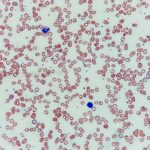
What is methemoglobinemia? During normal oxygen binding to hemoglobin, a small portion of hemoglobin undergoes oxidation leading to the conversion of iron from the ferrous (Fe²⁺) to ferric (Fe³⁺) state. Hemoglobin with iron in the Fe³⁺ state is called “methemoglobin” which is incapable of binding to oxygen and delivering it to the body. Methemoglobin is formed in normal conditions due to the inevitable process of oxidation leading to a dysfunctional hemoglobin. However, our bodies can revert to the normal hemoglobin in the Fe²⁺ state by using enzymes such as the cytochrome b5 reductase. In normal conditions, the formation of methemoglobin is small and does not lead to any clinical consequences. However, if there is a condition that significantly increases the amount of methemoglobin (usually above 12%), consequences such as cyanosis and hypoxia could occur.
Causes of Methemoglobinemia
- Congenital Methemoglobinemia:
- Cytochrome b5 reductase (Cyb5R) deficiency:
- Type I: Milder form limited only to red blood cells causing mild cyanosis.
- Type II: Affects all cells in the body and leads to more significant cyanosis and other clinical consequences. Mostly found in individuals from Siberia, Alaska, Puerto Rico, and Navajo peoples.
- Hemoglobin M Disease: Genetic mutations in the hemoglobin M (hemoglobin variants may include Boston, Fort Ripley, Hyde Park, Iwate, Kankakee, Osaka, SaskatoonHbM Boston).
2. Acquired Methemoglobinemia
- Medications: Common causes include topical anesthetics (such as benzocaine used in endoscopy suites, lidocaine, and prilocaine usually added to street drugs), dapsone (including topical and systemic), antimalarials such as hydroxychloroquine, rasburicase (more if concurrent G6PD deficiency), among other drugs.
- Chemicals/Environmental: Aniline dyes, nitrites (frozen or dried foods), mushrooms, well water (blue baby syndrome), antifreeze, root vegetables, leafy green vegetables, and other vegetables.
When to Suspect Methemoglobinemia?
Suspect methemoglobinemia in a patient with hypoxia that does not respond to oxygen administration. Cyanosis that is out of proportion to the oxygen saturation can be found. The classic triad includes cyanosis, hypoxia, and chocolate or blue-colored blood. Blood may become darker in color due to the presence of deoxygenated hemoglobin.

Clinical features are not exclusive to methemoglobinemia. Therefore, a low index of suspicion is required for the diagnosis of this disorder. Clinical manifestations can include:
- Cyanosis
- Pallor
- Fatigue and generalized weakness
- Headache
- Central nervous system depression
- Metabolic acidosis
- Seizures
- Dysrhythmias
- Coma and death
Diagnosis of Methemoglobinemia
- The diagnosis is clinical when there is the presence of oxygen-refractory hypoxemia, clinical features in particular of hypoperfusion (cyanosis, pallor, etc.), and the presence of a potential risk factor.
- Confirmation is achieved by arterial or venous blood gas with co-oximetry with measurement of methemoglobin concentration and percentage.
- Of note, methemoglobin affects the measurement of pulse oximetry which could be another indication of methemoglobinemia.
- Genetic testing for cytochrome b5 reductase can also be considered if no clear cause of methemoglobinemia is found or history of recurrent episodes of hypoxemia.
Management of Methemoglobinemia

Treatment of Acquired Methemoglobinemia
Acquired methemoglobinuria is a medical emergency that requires prompt diagnosis and management to prevent fatal complications.
- Stop the possible cause or exposure.
- Administer supplemental oxygen (high flow) and other supportive measures.
- Observation: It is appropriate to observe asymptomatic patients who have methemoglobin <30%.
- Methylene blue: Used when severe symptoms occur and/or mеthеmοglobin levels >30 percent. Avoid the use of methylene blue in individuals with G6PD deficiency although it is not an absolute contraindication.
- An alternative to methylene blue when not able to use it is ascorbic acid.
- If no good response to methylene blue, alternative treatments include ascorbic acid, exchange transfusion, and hyperbaric oxygen therapy.
Treatment of Congenital Methemoglobinemia due to Cyb5R deficiency includes:
- Supportive care during acute events and other interventions similar to the management of acquired methemoglobinemia as mentioned above.
- For cosmetic purposes can consider methylene blue 100-300 mg daily combined with vitamin C 1,000 mg once daily.
Adverse Events of Methylene Blue:
It is important to familiarize yourself with the side effect profile of methylene blue, including:
- Green or blue discoloration of urine (generally harmless).
- Serotonin syndrome: Methylene blue is an inhibitor of monoamine oxidase A. The risk of serotonin syndrome increases when patients are on psychiatric medications such as serotonin release inhibitors or MAO-A.
- As an oxidizing agent, methylene blue can precipitate methemoglobinemia or hemolysis in high doses or when ineffectively reduced.
- Hemolysis in individuals with G6PD (not an absolute contraindication but should be used with caution).
- Teratogenicity: category X drug in pregnancy.
We hope you enjoyed this post! Please, leave us any comments or questions below. Feel free to rate our post using the star system below if your time allows. Your feedback is important to us. Thank you!





